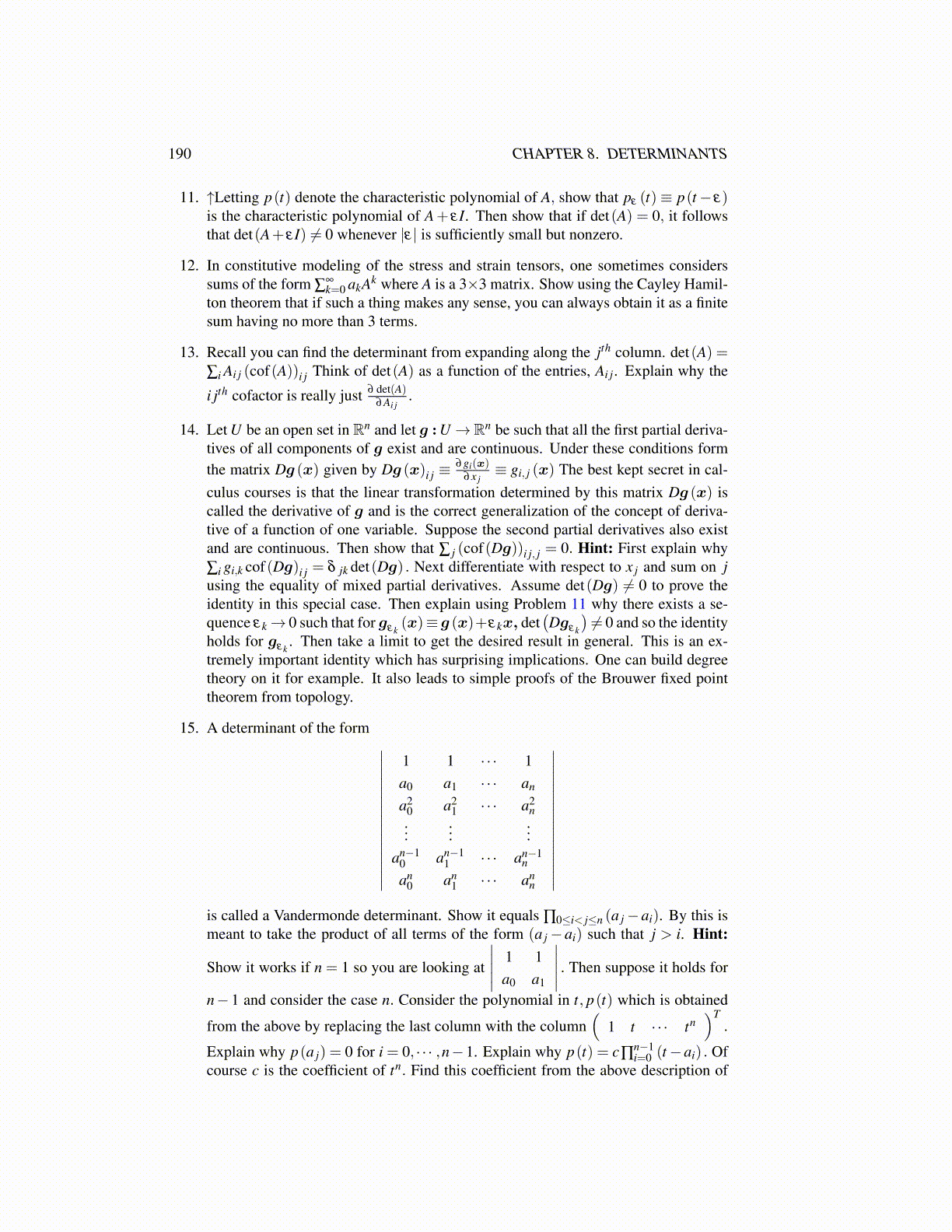
190 CHAPTER 8. DETERMINANTS
11. ↑Letting p(t) denote the characteristic polynomial of A, show that pε (t)≡ p(t− ε)is the characteristic polynomial of A+ εI. Then show that if det(A) = 0, it followsthat det(A+ εI) ̸= 0 whenever |ε| is sufficiently small but nonzero.
12. In constitutive modeling of the stress and strain tensors, one sometimes considerssums of the form ∑
∞k=0 akAk where A is a 3×3 matrix. Show using the Cayley Hamil-
ton theorem that if such a thing makes any sense, you can always obtain it as a finitesum having no more than 3 terms.
13. Recall you can find the determinant from expanding along the jth column. det(A) =∑i Ai j (cof(A))i j Think of det(A) as a function of the entries, Ai j. Explain why the
i jth cofactor is really just ∂ det(A)∂Ai j
.
14. Let U be an open set in Rn and let g :U→Rn be such that all the first partial deriva-tives of all components of g exist and are continuous. Under these conditions formthe matrix Dg (x) given by Dg (x)i j ≡
∂gi(x)∂x j≡ gi, j (x) The best kept secret in cal-
culus courses is that the linear transformation determined by this matrix Dg (x) iscalled the derivative of g and is the correct generalization of the concept of deriva-tive of a function of one variable. Suppose the second partial derivatives also existand are continuous. Then show that ∑ j (cof(Dg))i j, j = 0. Hint: First explain why∑i gi,k cof(Dg)i j = δ jk det(Dg) . Next differentiate with respect to x j and sum on jusing the equality of mixed partial derivatives. Assume det(Dg) ̸= 0 to prove theidentity in this special case. Then explain using Problem 11 why there exists a se-quence εk→ 0 such that for gεk
(x)≡ g (x)+εkx, det(Dgεk
)̸= 0 and so the identity
holds for gεk. Then take a limit to get the desired result in general. This is an ex-
tremely important identity which has surprising implications. One can build degreetheory on it for example. It also leads to simple proofs of the Brouwer fixed pointtheorem from topology.
15. A determinant of the form ∣∣∣∣∣∣∣∣∣∣∣∣∣∣∣
1 1 · · · 1a0 a1 · · · an
a20 a2
1 · · · a2n
......
...an−1
0 an−11 · · · an−1
n
an0 an
1 · · · ann
∣∣∣∣∣∣∣∣∣∣∣∣∣∣∣is called a Vandermonde determinant. Show it equals ∏0≤i< j≤n (a j−ai). By this ismeant to take the product of all terms of the form (a j−ai) such that j > i. Hint:
Show it works if n = 1 so you are looking at
∣∣∣∣∣ 1 1a0 a1
∣∣∣∣∣ . Then suppose it holds for
n− 1 and consider the case n. Consider the polynomial in t, p(t) which is obtained
from the above by replacing the last column with the column(
1 t · · · tn)T
.
Explain why p(a j) = 0 for i = 0, · · · ,n−1. Explain why p(t) = c∏n−1i=0 (t−ai) . Of
course c is the coefficient of tn. Find this coefficient from the above description of